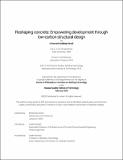Reshaping concrete: Empowering development through low-carbon structural design
Author(s)
Ismail, Mohamed Abdelbagi
DownloadThesis PDF (13.24Mb)
Advisor
Mueller, Caitlin
Terms of use
Metadata
Show full item recordAbstract
Less Economically Developed Countries (LEDCs) are struggling to meet the demand for affordable housing in their growing cities. There are several reasons for this, but a major constraint is the high cost of construction materials. In LEDCs, material costs can constitute up to 90% of the total cost of residential construction. Importantly, structural systems for multi-story housing in LEDCs are nearly always constructed in reinforced concrete and typically use structurally inefficient typologies like prismatic beams and flat slabs despite their structural material waste. This is because their construction mimics the materially inefficient practices of the More Economically Developed Countries (MEDCs), which were developed to reduce labor over material costs. The mounting use of steel-reinforced concrete structures in LEDC cities also raises concern about the environmental costs of construction; construction accounts for 20-30% of LEDC carbon emissions.
This dissertation addresses these challenges with a set of strategies for the design and analysis of materially efficient concrete elements that can reduce the economic and environmental costs of urban construction. Developed to meet the constraints of LEDCs, structural elements are optimized to reduce the embodied carbon associated with the concrete and reinforcing steel while resisting the same loads as a standard building structure. These strategies include a novel approach to 3D shape parameterization, as well as a decoupled analytical engineering analysis method that accounts for the key failure modes and code-based constraints of reinforced concrete design. This method is verified through design examples that show how the embodied energy and carbon of concrete floor systems can be reduced by over 60% through shape optimization. Prototypes are fabricated and load tested to verify the efficacy of the structural design method, and to illustrate its ability to generate fabricable designs in an LEDC construction context. Finally, in order to broaden its potential impact, this research involves the development of accessible tools and methods for designers and stakeholders in LEDCs. The thesis presents an open-source toolset for the design and analysis of complex concrete elements and an intuitive design interface to communicate the performance and visual impact of materially efficient structures in real-time during early-stage design phases. This is especially useful in designs with exposed structural systems, allowing structural performance to play a key role in the final architecture.
This thesis presents several strategies for the design of efficient concrete structures that allow us to build far more with far less, reducing the environmental and economic costs of construction while responding to the needs of LEDCs. These methods may enable the design of concrete elements for multiple performance criteria such as structural behavior, acoustic transmission, and thermal mass. They can also enable an accessible design practice through machine learning, real-time iterative workflows, and visualization tools that include the end user in the architectural design process.
Keywords: reinforced concrete, shape optimization, digital fabrication, stress testing, machine learning,
development, sustainability
Date issued
2023-02Department
Massachusetts Institute of Technology. Department of ArchitecturePublisher
Massachusetts Institute of Technology